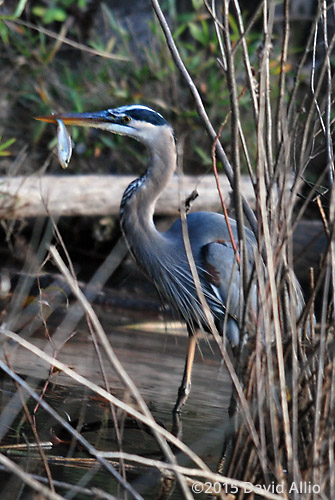A Great Blue Heron Ardea herodias wades along the Lake Blalock, South Carolina, shoreline after dusk with evidence of successful fishing. The backstory on the photograph involves a sighting of the bird about an hour before dusk, a round of hide-and-seek, long minutes of waiting as the sun sets, and an exposure after dark.
Experience indicates that birds of all sizes are leery of people and cameras. This Great Blue Heron was first sighted wading in open water but as I approached it quickly moved to the cover of vegetation. For over an hour it would peek through narrow openings, seemingly waiting for me to leave or the sun to drop below the cloudless horizon. The sun set and the bird had hardly moved. Light receded and still the bird waited. Finally, possibly convinced of the cover of darkness, the bird moved to capture a fish. Exposure made.
How important is a good lens?
The data below explains that a consumer-level camera body was mounted to a professional-grade large-aperture telephoto lens with vibration reduction "on." Do not mistake this photograph as a snapshot or a digital image manipulated by software. Value the glass more than the camera for a successful low-light exposure.
camera: Nikon D60 | lens: AF Nikkor VR 400mm f/2.8G IF-ED
focal length: 400mm | exposure: f/2.8 – 1/6th – ISO 400
accessories: monopod
